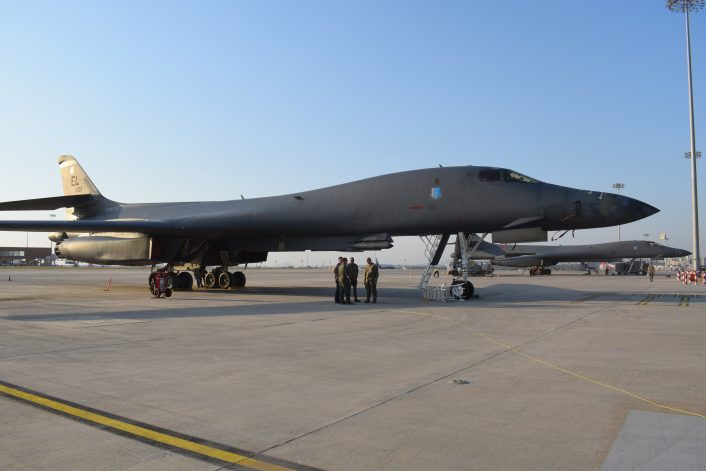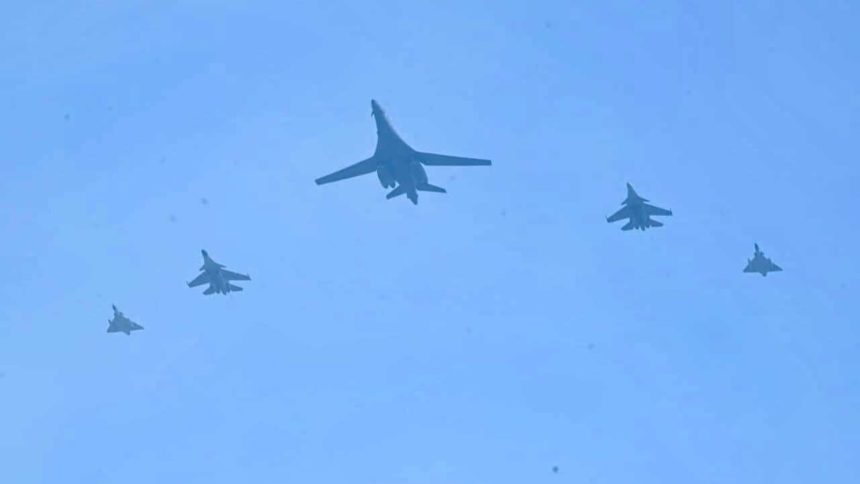A B-1B took part in a four-day exercise with the Indian Air Force, marking the first return to the country since the participation to the Cope India 2023 exercise.
A single U.S. Air Force B-1B Lancer bomber participated in a four-day exercise with the Indian Air Force, which the service said ran from Nov. 10 to Nov. 13, 2025. Images released by the Indian Air Force on Nov. 12 showed the BONE flying with three Mirage 2000s and two Su-30MKIs.
Both sides have released little information about the drills, with the IAF calling it a “bilateral exercise […] aimed at fostering mutual learning and enhancing interoperability,” while also confirming that the USAF participated with the B-1B. It is also unclear if the exercise is a part of the larger Cope India 2025 bilateral exercise of the Indian and U.S Air Forces.
The B-1B was also spotted a day later at Bengaluru airport in southern India’s Karnataka state. The B-1B is assigned to the 9th Bomb Squadron (9th BS), part of the 7th Bomb Wing (7th Bomb Wing) at Dyess AFB, Texas. The B-1B Lancer can be concluded to be a part of the four-aircraft Bomber Task Force (BTF) contingent currently deployed to Japan’s Misawa Air Base, that departed Dyess AFB on Oct. 16.
INDIA–US AIR EXERCISE
The Indian Air Force and United States Air Force are engaged in a bilateral exercise from 10–13 Nov 25, aimed at fostering mutual learning and enhancing interoperability.
USAF is participating with the B-1B Lancer.#IAF #USAF #Interoperability… pic.twitter.com/49z1jYsv91
— Indian Air Force (@IAF_MCC) November 12, 2025
Previous B-1B visits in India and China
This is not the first time the B-1B lands in India, since two of the jets participated in the 2023 edition of Aero India in Bengaluru in February 2023. Two months later, they proceeded to take part in joint drills with the IAF for the 11-day Cope India 2023, participating in its second phase.
On Apr. 10, 2023, then commander of the U.S. Pacific Air Forces (PACAF) Gen. Kenneth S. Wilsbach had told the press in India that the American assets for Cope India 2023’s phase II would also include four to six F-15Es, one C-17 and two C-130s, beside the two B-1 bombers.

The participation of the B-1 also comes amid sensationalist rumors about the U.S. pitching the B-1 to India to be purchased or even leased. This is inconceivable under U.S. politico-strategic doctrine, which has never considered offering any of its frontline strategic strike aircraft to even the closest ally.
B‑1B Lancer was spotted today at Bengaluru, ahead of Exercise Cope India 2025…😍 pic.twitter.com/EIKQhxIp54
— Concerned (@Bundela_4415) November 13, 2025
A possible motive could be to explore basing rights in India for operations against China, given both New Delhi and Washington’s mutual hostility with the country. The USAF operates the Congressionally-mandated fleet of 45 B-1B Lancers, a figure that reached again after regenerating aircraft 86-0115 “Rage” in July 2024. The need to regenerate the aircraft was because another B-1B Lancer, serial 85-0089, also of the 7th BW at Dyess AFB, suffered a catastrophic engine failure on Apr. 20, 2022.
The Cope India 2023 drills laid the foundation for the basic interoperability between the two air forces with respect to the B-2, with a view to offset the threat posed by China’s H-6K bomber, which has been spotted at its Himalayan bases in and around Tibet. Both the drills could also be meant for strategic signaling to deter ambitious Chinese designs.
6th edition of Cope India-2023, an Air Exercise between the Indian Air Force (IAF) and United States Air Force (USAF), conducted over the last two weeks at Air Force Stations Kalaikunda, Panagarh and Agra, culminates. pic.twitter.com/CqxyC0Y8rx
— Sidhant Sibal (@sidhant) April 25, 2023
Both India and the U.S. have also signed a series of military logistics, support and communications interoperability agreements over the years, short of allowing a full-fledged military base. Such a facility would be geopolitically and diplomatically constrained, as India-China relations have not deteriorated to that level.
Ordinarily, India would not consider such a request, especially during a Taiwan contingency, when Washington is most likely to seek that option. Basing its strategic bombers far from the western Pacific, yet closer to China, allows opening another front, lest India is willing to be drawn into the conflict and become a legitimate target for Chinese strikes.

Latest exercise
Neither service has specified the kind of missions the B-1B Lancer flew with the Su-30s and the Mirage 2000s, but the drills may have involved refining basic communication and formation flying protocols.
Generally, when B-1s routinely exercise with large South Korean and Japanese aircraft formations, the drills focus on joint strike and combined operations, with the RoKAF and JASDF F-15Ks, F-15Js and F-35As providing protection from enemy fighters and ground-based air defenses.
It will take several such drills and even political willingness in both capitals to align U.S. and Indian security interests to the U.S.-South Korea and U.S.-Japan level. Interestingly, the IAF’s Rafales do not seem to be included in the drills, and it is not known whether the clash with Pakistan has a role to play.

As for the Cope India exercise, this would be the exercise’s seventh iteration, after the first was held in February 2004. Subsequent installations were seen in 2005, 2006, 2009, 2018 and 2013.
India-U.S. defense pact
On Oct. 31, India and the U.S. signed a “framework agreement” to expand defense cooperation over the next 10 years, with the pact inked by defense minister Rajnath Singh and Secretary of War Pete Hegseth at Kuala Lumpur in Malaysia. This was on the sidelines of the 12th ASEAN Defence Ministers’ Meeting-Plus (ADMM-Plus).
The agreement will enhance “coordination, information sharing and tech cooperation” and advance “regional stability and deterrence,” Hegseth said on X. “It is a signal of our growing strategic convergence and will herald a new decade of partnership. Defence will remain as a major pillar of our bilateral relations. Our partnership is critical for ensuring a free, open and rules-based Indo-Pacific region,” Singh said in a post on X.









